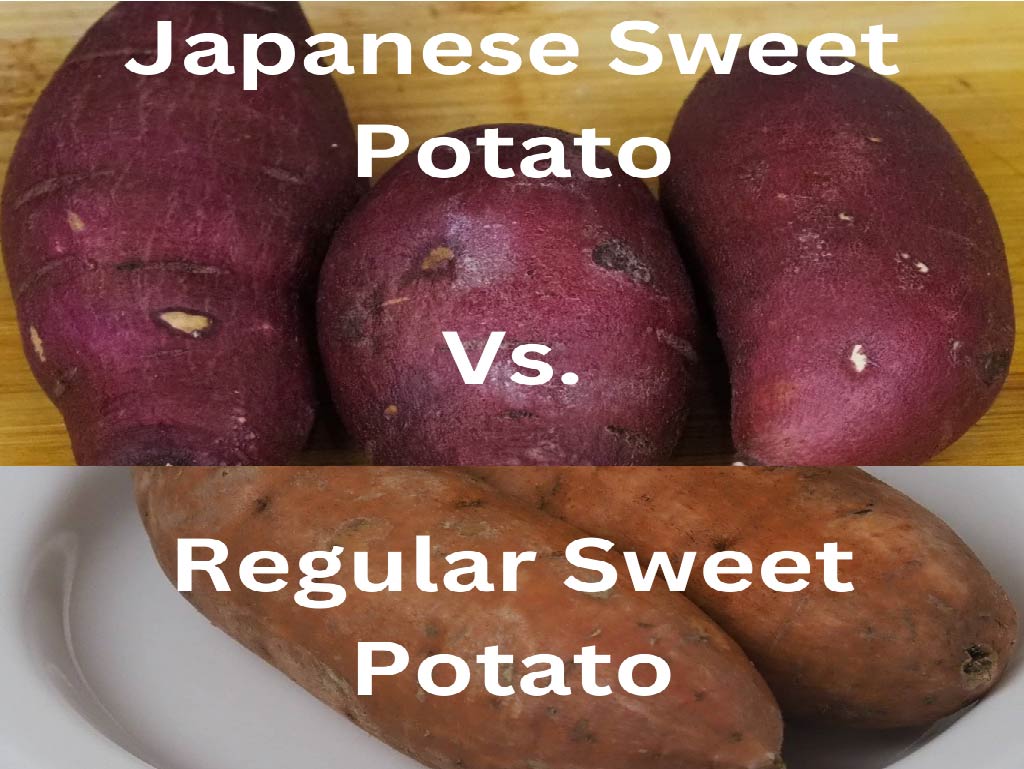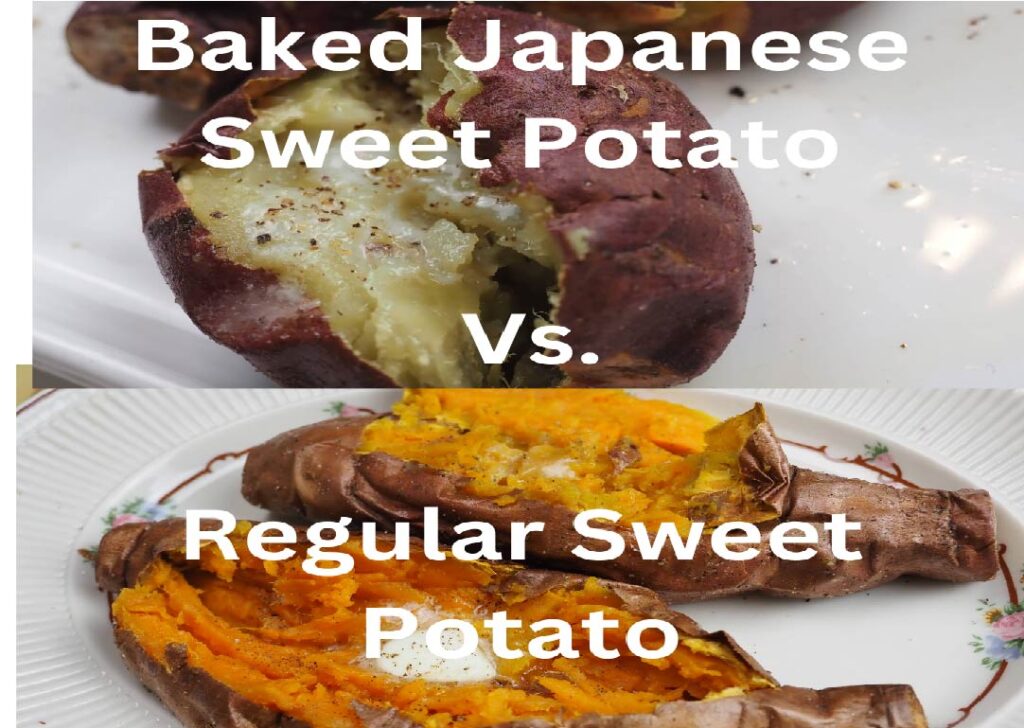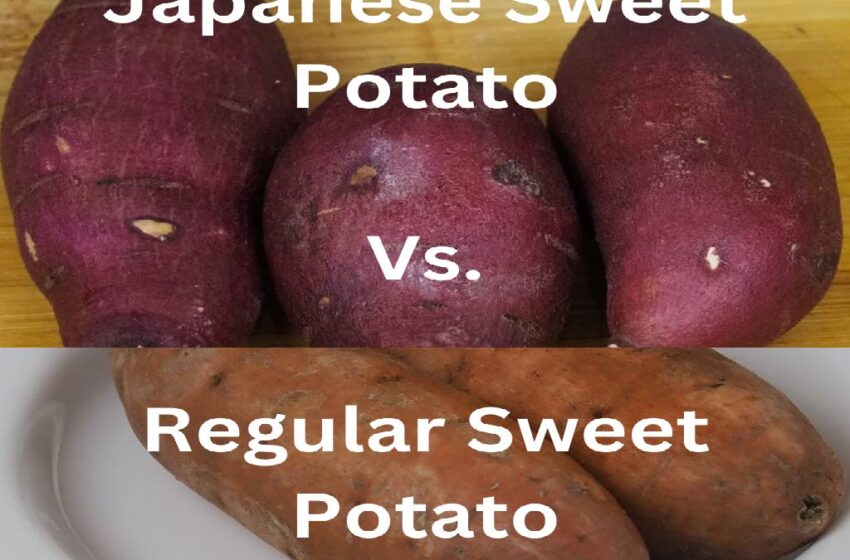Sweet potatoes are valued and adaptable worldwide. Many cuisines use them due of their distinct taste, brilliant colors, and impressive nutritional profiles. We’ll explore the fascinating world of sweet potatoes and compare two popular types, Japanese and sweet.
Foodies love Satsumaimo, Japanese sweet potatoes. Their stunning purple or scarlet exterior, creamy white flesh, and sweet, chestnut-like flavor distinguish them. Common sweet potatoes, scientifically known as Ipomoea batatas, are orange, yellow, purple, or white and have different tastes.
For different types of sweet potato, Check: Types of sweet potato
Comparison of Color and Appearance of Japanese Sweet Potato with Other Sweet Potato
When it comes to color and look, sweet potatoes and Japanese sweet potatoes are very different.

Satsumaimo, which is another name for Japanese sweet potatoes, come in a wide range of bright colors. The most common types have skin that is reddish-purple or deep reddish-brown and flesh that is pale and creamy white. Japanese sweet potatoes usually have firm, smooth, and moist flesh.
The different colors of Japanese sweet potatoes can add an interesting visual feature to different dishes, making them more appealing to look at. Because of their bright colors, they stand out in both traditional Japanese food and newer dishes.
On the other hand, sweet potatoes come in many different colors and shapes. The orange-fleshed sweet potato is the most well-known kind. It usually has a reddish-brown or copper-colored skin and bright orange flesh. But there are many other kinds that are different colors. The inside of some sweet potatoes is white or cream-colored, while the inside of others is purple or even yellow.
Comparision of Baked Japanese Sweet Potato with Other Verities

Japanese sweet potato with pale and creamy inside while other being orange color.
My personal experience: Though regular sweet potato tastes good; I loved Japanese baked sweet potato.
Comparision of Japanese Sweet Potato Fries with other verities

My personal favorite is Japanese sweet potato fries.
Nutrition Profile Comparision of Japanese Sweet Potato with Other Verities of Sweet Potato
For detailed information on sweet potato nutrition, read: Sweet Potato Nutrition and Japanese Sweet Potato Nutrition
There isn’t much difference between the nutrition content between Japanese sweet potato and other verities. They all have similar calories, vitamins, minerals and antioxidants. Below provided are the lists of nutrients, vitamins and minerals found in Japanese sweet potato.
| Nutrition Facts of Japanese Sweet Potato [1] | |
| Serving Size: 1 medium (2″ dia, 5″ long, raw) – (114 grams) | |
| Amount Per Serving | |
| Calories | 103 |
| Total Fat | 0.2 grams |
| Cholesterol | 0 milligrams |
| Sodium | 41 milligrams |
| Total Carbohydrates | 24 grams |
| Dietary Fiber | 3.8 grams |
| Sugars | 7.4 grams |
| Protein | 2.3 grams |
| Vitamin D | 0 micrograms |
| Calcium | 43 milligrams |
| Iron | 0.8 milligrams |
| Potassium | 541.5 milligrams |
| Caffeine | 0 milligrams |
| *The % Daily Value (DV) tells you how much a nutrient in a serving of food contributes to a daily diet. 2000 calories a day is used for general nutrition advice. |
Vitamins and antioxidants present per 200 g in Japanese Sweet Potato [2]
- Thiamine: 0.22 milligram
- Riboflavin: 0.06 milligram
- Niacin: 1.6 milligrams
- Vitamin B6: 0.56 milligram
- Folate: 98 micrograms
- Pantothenic acid: 1.92 milligrams
- Biotin: 8 milligrams
- Vitamin C: 58 milligrams
- Vitamin E: 3.2 milligrams
Minerals found in 200g of Japanese Sweet Potato [2]
| Nutrient | Amount |
| Sodium | 8mg |
| Potassium | 940mg |
| Calcium | 80mg |
| Magnesium | 50mg |
| Phosphorus | 92mg |
| Iron | 1.4mg |
| Zinc | 0.4mg |
| Copper | 0.36mg |
| Manganese | 0.88mg |
| Iodine | 2μg |
| Chromium | 4μg |
| Molybdenum | 8μg |
Availability and Shopping Tips for Japanese Sweet Potato Vs. Other Verities of Sweet Potato
When buying Japanese sweet potatoes and other verities of sweet potatoes, it helps to know where to find them, when they are in season, how to pick the best quality, and how to store them so they stay fresh. Here are some tips that will help you find what you want and shop for it:
Where to Find Japanese Sweet Potatoes and other Sweet Potatoes
You can find common sweet potatoes in most grocery shops, supermarkets, and farmers’ markets all year long. They are usually found with other root vegetables in the produce area.
However, satsumaimo, which is another name for Japanese sweet potatoes, can be found in Asian grocery shops, especially those that sell a lot of Japanese food. They might also be sold at local farmer’s markets or specialty food shops with a wide range of ingredients from around the world.
Sweet Potatoes:
Seasonality and Availability
Satsumaimo is usually available all year long in places where it is grown. But their busiest time changes from place to place. For example, in Japan, they are picked from late summer to early fall.
Whereas, in many places, you can also get sweet potatoes all year long, though some types may have busier times. Depending on the type, they are usually picked between the end of summer and the beginning of winter.
Choosing the Best Quality and Freshness
- Look for potatoes with smooth, unspotted skins and no mold or other signs of decay.
- Choose potatoes that are heavy for their size and feel hard.
- For Japanese sweet potatoes, choose ones with smooth, bright-colored skins that don’t have any soft spots or wrinkles.
- Sweet potatoes can have different-colored skins, but make sure the skin is whole and free of big cuts or bruises.
- Choose medium-sized potatoes because they usually have a good mix of taste and texture.
Tips for storing food to make it last longer
Follow these rules for storing Japanese sweet potatoes as well as other sweet potato types to make them last longer and keep their quality:
- Put them away from direct sunlight in a cool, dry, well-ventilated place.
- Don’t put raw sweet potatoes in the fridge because the cold can change the way they taste and feel.
- Use a bag that lets air in or wrap them loosely in paper towels to keep wetness from building up.
- For the best taste and texture, eat them within a week or two.
- Cooked sweet potatoes can be kept in the fridge for up to 4-5 days in a jar with no holes.
- If you know where to find these plants, when they are in season, how to pick the best ones, and how to store them properly, you can use fresh and tasty Japanese sweet potatoes and sweet potatoes in your cooking.
